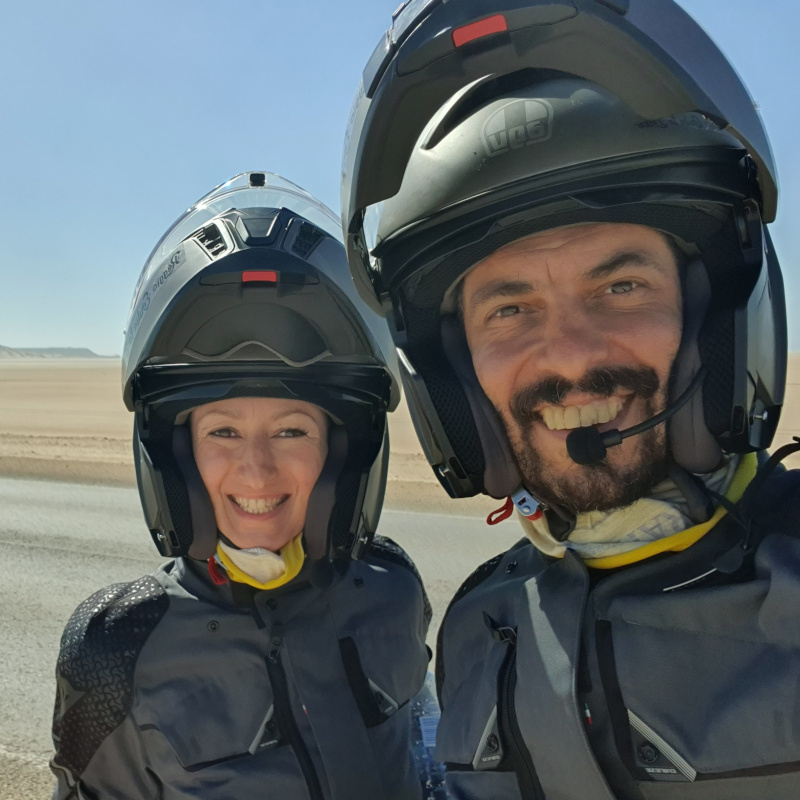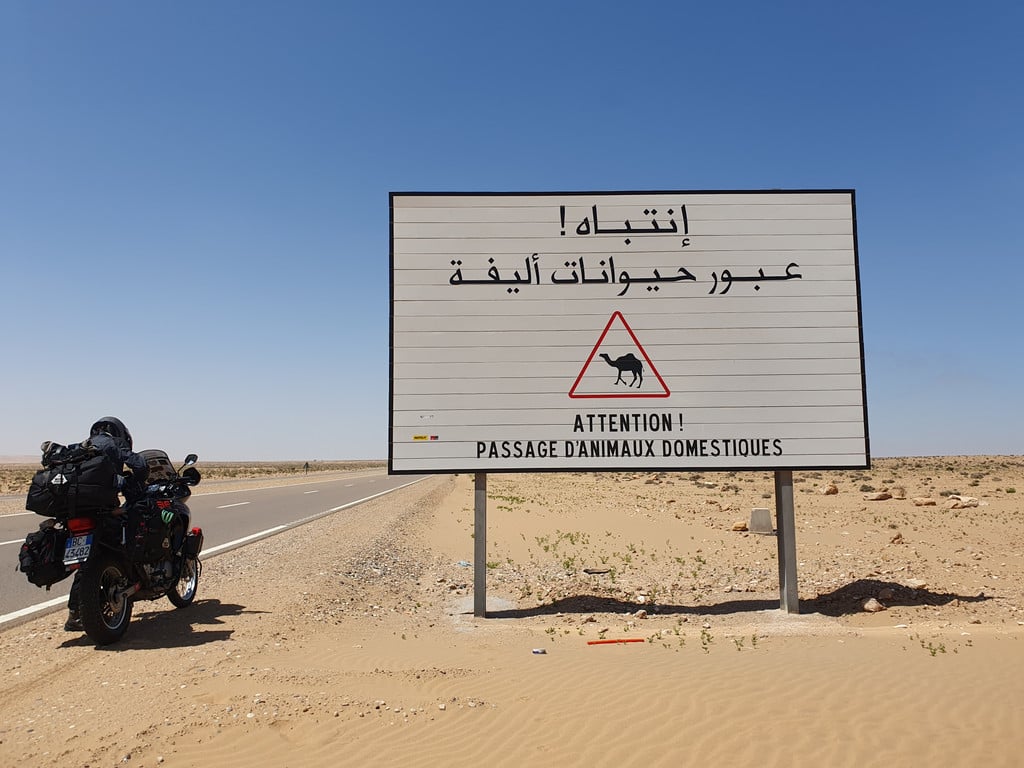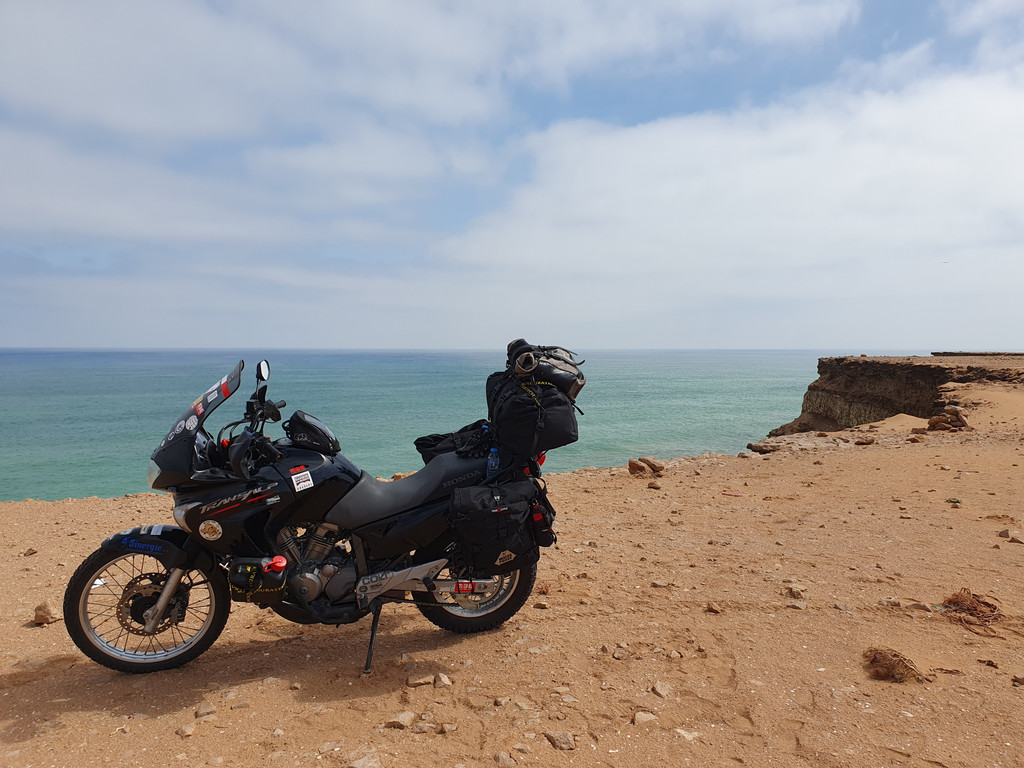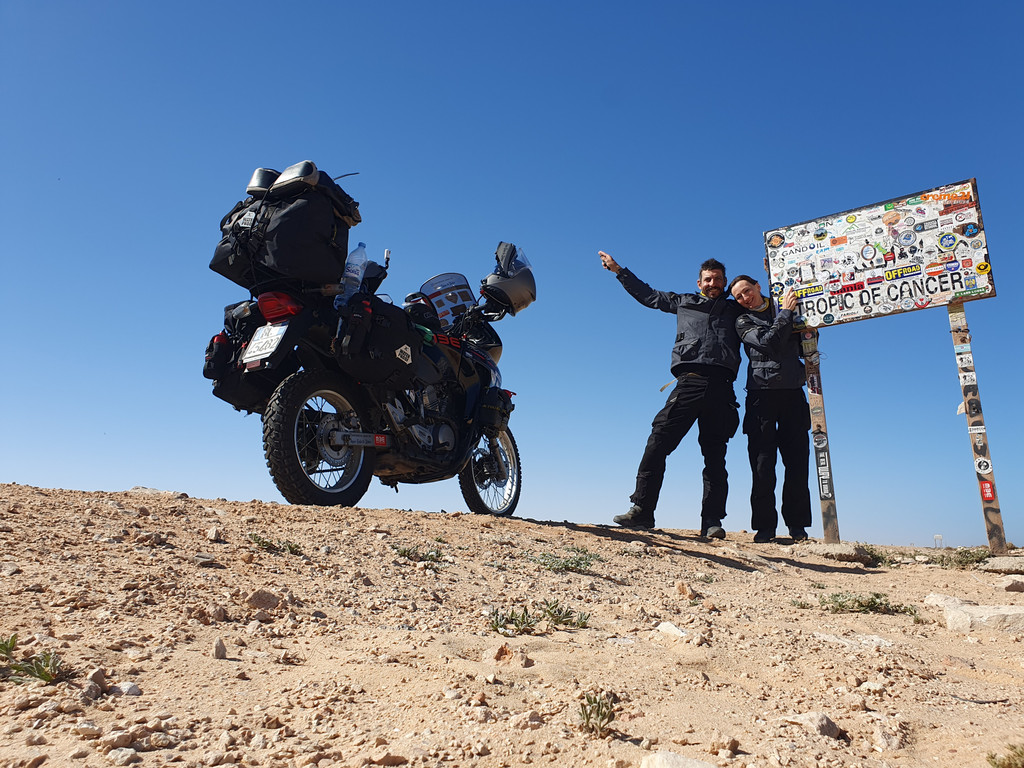
We’re from Reggio Emilia and are passionate about traveling and exploring – we share our adventures on our Instagram profile @maurisilviamototravellers. We love the mountains and often go to our Tuscan-Emilian Apennines, but we also want to travel the world on our motorcycles and in April 2023 we fulfilled our first dream – a motorcycle journey in Africa for an NGO. We combined the trip we dreamt of with a charitable purpose, and we hope that this will be only the first of many expeditions.
Leaving for this motorcycle journey in Africa was no small matter. First of all, this wasn’t just a trip – we were on a mission. We wanted to tour Africa on a motorcycle but also do some good; so we contacted the Bambini nel Deserto (Children in the Desert) NGO to see how we could help and they told us about Casamance, a region in south Senegal. We raised the necessary funds to start a small textile enterprise in a village near Sédhiou; over four months, from January to April, we devoted all our spare time to this project, as well as to organizing and preparing the trip itself.
Fundraising was a great success: The goal was to raise €5,000 to start the project and, instead, we raised €8,000, so that we also managed to buy the motorcycle we needed for the journey in order to come back by plane, as we had limited time. At the end, we were going to leave the motorcycle in Dakar as a donation.
Dainese helped us a lot, by providing us with the right equipment – three-layer jacket and pants, modular and suited to all climates, from rainy, cold weather to the desert heat, as well as adventure boots, helmet and technical underwear. The three-layer – or four-season – outfit was perfect. We left Italy when it was about 10 °C and even in the north of Morocco it wasn’t warm at all; then we traveled southward and as the temperatures rose, we started using jacket and pants in their more ventilated configuration.

We equipped ourselves with soft bags, as they have more capacity, but above all so that we could easily bring them back with us on the plane. In any case, our luggage was minimal – underwear, a few T-shirts, a pair of long and short pants each, and a vanity case full of mini size toiletries, which of course included sunscreen. We also brought along a camping stove, coffee machine and essential food for the most extreme situations, and I must say that it came in handy.
The itinerary was very easy to plan – from Tangier, straight down to the south, and we booked only the first two nights’ accommodation from Italy.
We feel very emotional. After having dreamt and fantasized about it so much, and after all the preparations, our motorcycle journey to Senegal has finally begun. We’re at the head of the queue in front of the ship and as soon as we’re off, we’re already raring to go back on the motorcycle and start riding. During the crossing, we develop a key skill that will prove useful throughout the trip – patience. We get on the ferry at 2 p.m. on April 22, and disembark in Tangier at 10 p.m. on April 24.
Though it’s late at night when we arrive at the port of Tangier, we just want to quickly reach our first stop in Asilah. We booked accommodation just outside Tangier, so as to already be heading in the right direction tomorrow morning. It’s night, but the signs in Arabic and the roofs of the mosques lit up in green make us realize that we’re on another continent; we’re thrilled and we’re already breathing in a different atmosphere. Tomorrow morning we’ll leave for Marrakesh – about 550 km away.
In this area, the roads are nice, but we decide to take the highway, to shorten the route. We leave wearing our outfits in winter configuration, as close to the ocean, in the morning, the temperature is quite cool; the more we travel inland, toward Marrakesh, the more the temperature rises. We reach our destination towards 6 p.m.; this is how it’ll be pretty much every day – riding all day to reach the next stage as soon as possible. We have 13 days to get to Casamance, our goal, and we want to spend at least two days there, then go back to Dakar and take the plane back. We need to make it by May 9, the day we’re due to come back to Italy.

In the meantime, we enjoy our first evening in a large Moroccan city, Marrakesh, losing ourselves in its alleyways where everyone’s on a moped, tuk tuk and other unusual motorized vehicles, and we dive into the chaotic atmosphere – it’s intoxicating! Back at our riad, we look at the map and choose our destination for tomorrow, something that we’ll be doing every night during our journey – study the itinerary and book the accommodation for the following day. Actually, in some cases we ended up booking on the day, always using our trusty booking website. We don’t choose at random. Our accommodation has to fulfil at least two fundamental requirements – cost as little as possible and have motorcycle parking.
The next day, we head toward Tifnit, a fishing village on the Atlantic Ocean, south of Agadir. It’s a beautiful ride, the Ocean always on our right, the wind, the changing landscape that from green acquires increasingly earthen tones; we’re no longer on the highway but on a coastal road, it all begins to be a bit wilder – goats and cows take over the road, and we start seeing the first dromedaries.

We spend the night in an eco-lodge on the ocean and actually try to take a swim, but the water is really cold so we just have a paddle. We dine in the kitchen of the owner, who makes us a delicious tajine, together with a French family who’s also staying there. You meet so many nice people when traveling!
Our next destination is Tan-Tan Plage, but we know we have to stop at the Legzira Arch, a site not to be missed. We’ve seen lots of pictures of this wonderful natural arch made entirely of sand, but admiring it in real life feels really emotional – it’s an imposing sight and riding the motorcycle along the beach and under it actually makes us weep with joy under our helmets. Tan-Tan Plage seems like an uninhabited village, with so few tourists coming here that we struggle to find a place to dine, but we had to stop here and tomorrow we’ll leave early – we have so much more to see.
The next stretch is from Tan-Tan Plage to Laayoune. Here, we start encountering the first real desert dunes; there are ever fewer people on the road – it’s just us, camels and the usual checkpoints when entering a city. By the way, if you’d like to take a trip like ours, don’t forget to bring along some pre-filled forms. They’re small forms showing all your personal and motorcycle details, to be handed over to the police instead of all the various documentation, so that it’s much easier to cross the border – you can find several examples on the internet. The city of Laayoune is part of Western Sahara, a territory disputed by the Sahrawi Arab Democratic Republic – it’s a more modern city and we find a new hotel featuring all Western comforts.
We get up and head toward Dakhla. We really start to feel the desert now, though the ocean is still on our right and the wind blows very strong. We reach the Dakhla Valley and are mesmerized by the dunes all around us. It feels as if we’re the only people in the world, there are no cars at all, and we stop to take thousands of photos, still in our full outfits as we are swept by wind and sand. We continue and go back to the Atlantic Ocean – there are a lot of surfers and kite surfers and we’re riding on a stretch of land surrounded by the sea on both sides. Dakhla is just a detour. Tomorrow we’ll have to take the same road to go back as this is a peninsula, but it’s really worth it – actually, we’d stay a day longer if we could.
The next stage is a challenging one. We have to enter Mauritania and cross our first border; but first, another significant milestone, a line all travelers must cross – the Tropic of Cancer. We’ve now reached the real desert, though we still feel the wind and smell the scent of the ocean nearby. We leave our own mark – a sticker with our logo and those of our friends and of Children in the Desert. But we must go on – Mauritania awaits us.

We reach the El Guergarat border post at about midday and we find it closed for lunch and prayer; we wait an hour in the only restaurant-bar there, and then the adventure begins. Due to the various checks, it takes us about three hours to leave Morocco and enter Mauritania, even with the help of a so-called ‘passeur’, who should make it easier to cross. But we have to wait for a really long time anyway, under the scorching sun and visiting offices that seem straight out of a Tarantino movie. It’s a shame we couldn’t take any photos, as it’s absolutely forbidden.
We cross No-Man’s Land, a part of the desert where there are still landmines and which you have to cross with great care. It’s only a few kilometers long but it’s frightening – there’s no one around, only abandoned car wrecks.
We’re finally out – we’re in Mauritania. As soon as we’re there, we go past a level crossing and immediately stop, as the longest train in the world is going by! It’s three kilometers long and transports iron filings, travels for over 700 km and cuts the Sahara desert into two – it’s really long and we have time to take some photos. We feel the ground shaking. Some people board the train on the fly and take place directly on the heaps of iron filings, obviously wearing Tuareg dress. It’s a free ride and Mauritanians – and a few adventure-lovers – use it to travel within the country.
We continue on our way and reach Nouadhibou for the night. Here everything is completely different to Morocco. The city looks almost deserted, it feels like we’re the only foreigners, it’s all sandy roads and we have to wander quite a bit to find a place where we can eat. Finally, we find a ‘restaurant’ – we see people going in and decide to do the same. We ask for a beer but in Mauritania alcohol is forbidden and nobody sells any. They offer us a can of Heineken in any case, but for 15 euros! We politely refuse and go to bed early. Tomorrow we’ll cross the Mauritanian Desert – 550 km from Nouadhibou to Nouakchott, the capital of Mauritania, the most challenging stage.
We get up early in the morning, ready to leave, though we experience a small issue with our Transalp. The steering lock is stuck and the key doesn’t want to go in, we try several times and only after much lubricating oil we manage to get it working. There must have been some sand... Finally, we head off, already one hour late according to our schedule; we hit the road and as soon as we’re out of the city we’re back in the desert – the sun beats down on us and there’s a strong wind that actually makes the motorcycle tilt. We struggle to keep it straight. We continue against the wind. The road is empty, only us and the desert for as far as the eyes can see. The sand often blows onto the road, there are a lot of dromedaries, and the usual goats and cows block the road and refuse to budge, while the dromedaries gallop away as soon as you approach them.

We left with a good supply of drinking water but after a short time it’s already boiling hot; we stop at the only gas station we encounter to fill up but there’s no gas – thankfully we have the tanks with us. In any case, we stock up with water and wisely buy a packet of cookies and some dates, too – we don’t know it yet, but this will be our only food for the day.
We go on and there are no more towns or villages, only the desert, hypnotic and increasingly hot. We’re far from the ocean now and it feels like it. We start seeing mirages. The road down there seems liquid but there’s no water in sight; we look for a gas station, a small store, but there’s absolutely nothing, a tent here and there but nothing else.
We’re so hot it feels as if we’re burning from the inside. In this period the temperature should have been around 35 °C but it’s between 48 and 50 °C. We start to feel nauseous and have palpitations but we don’t say anything, only whisper to each other that we’re fine, so as not to lose heart. All we want is to be out of here but we’re only half-way through; we should have a rest but there’s no place to stop. Then we see a small building with an old off-road vehicle parked in front and we head straight there; as soon as we say “Salam alaykum” (the equivalent of our “hello”) they immediately understand that we need to drink something and give us some water – we pour two bottles over ourselves and dissolve some mineral salts in the other two. Seeing us in bad shape, they roll out a carpet for us in the shade of the shack, the only shade there is, so that we can rest, and offer us some mint tea. We stay for about half an hour and then, refreshed, we’re ready to continue the journey.
We leave and it’s still hellishly hot. It’s like having a hair dryer pointed straight at you, but when we finally get closer to the sea we start to revive; the temperature is only slightly cooler but at least now there’s some wind stirring the air.
As we approach the capital, the first street lamps begin to appear – an incredible sight in the middle of the desert – then the road gets larger, there are more lanes and more cars and we soon find ourselves in bustling Nouakchott. Tonight we’re sleeping in someone’s house, a local who rents rooms. We spend the evening with him and he even makes us dinner. Meeting the locals is always a pleasure, and getting to know their customs makes for an authentic experience.
The morning after we leave early. We have to cross the border into Senegal and we’d rather not have a repeat of our previous experience. We take the Diama road, 80 km of fantastic off-road passing through the Diawling National Park; you have to get an entry ticket for the park, which costs €7, and then you find yourself surrounded by nature, with animals happily walking around you, you just need to watch out for the warthogs crossing the road! Crossing the border after the Park is a much smoother experience than our previous one and in about an hour we leave Mauritania and enter Senegal.
We’re very excited. We see the landscape changing again – after the desert, here everything is finally much greener; we reach Saint-Louis and really feel how different it is from Mauritania, there’s music, colors, merriment – it’s a city that wins you over, where you can taste the real Africa. We’d like to stay for an additional night but we’re on a mission – indeed, we actually get a phone call, telling us that tomorrow we’ll have to make a detour to the middle of Senegal due to issues concerning the donation of the motorcycle; we’ll have to go to the Tienaba prefecture, so won’t be able to go to Dakar as planned.
Yet another challenging day – we ride for several more kilometers and then have to go back to our route and get as close as we can to the border with Gambia. We reach our destination at 10 p.m., we’re exhausted and just want to go to bed.
The following day, we’ll cross Gambia and finally reach CasaBio in Casamance, our goal, a training center for agritourism and educational farm. We’d heard terrible things about crossing into Gambia, that border control there is particularly corrupt, that we should pay whatever they might ask without a word and that we’d be waiting for hours; maybe because we’re on a motorcycle or perhaps because we stand out a bit, but we only meet nice people who stop us and want to hear about our story and our trip, and wish us well. Gambia is the smallest country in continental Africa and it’s an English-speaking enclave – to us, switching to English after so many days of French is weird, but we only meet friendly people.
In Casamance, we’re in the middle of the savannah, the road gets a bit rough, and there are roadworks everywhere – they’re building a main road and there are a lot of detours, and we always end up back on a red dirt road, surrounded by a cloud of dust. It’s a dirt road full of bumps and recently tilled; the vibration is relentless; this is the most challenging road we tackled, also because it’s very hot and humid again.
We take a break. For lunch we only have some mangos we bought from a woman at a stall on the road but they’re really delicious. We look around and see we’re under a huge baobab, in the middle of the savannah, with monkeys climbing on its branches – it’s like being in one of those documentaries we used to watch from the comfort of our sofa at home, but we’re really here and it’s beautiful.
We reach CasaBio, almost at the border with Guinea-Bissau, very much behind schedule and only Francesca, the project’s Italian manager, is there waiting for us. It’s a very emotional occasion nonetheless; she shows us everything and then takes us to a lodge nearby for the night, by car! It’s the first time we leave the motorcycle and, frankly, we’re quite happy to have someone else driving for a bit.

The morning after, they come to collect us and take us back to CasaBio, and here we are, our mission accomplished. Seeing our project completed and looking into the eyes of the women who’ll benefit from it is the most powerful moment of the whole journey. Witnessing the result of our efforts, commitment and work we did at home is an enormous satisfaction and, above all, this people’s happiness fills our hearts.
We stay for lunch, as they cooked for us; they sing us traditional songs and we dance together – it’s a truly magical day. Then, when we visit the village where they live and also meet the children, we realize that this isn’t the end, that we’ll be back. There’s a lot to be done and having seen how they live, we can’t just look the other way.
Our adventure is coming to an end, it’s our last night here and our hearts already ache. We’ll have to go back toward Dakar, where we’ll leave the motorcycle and take the plane back to Italy. The following day, thinking about the long way we’ve come, our head is full of images from Morocco, the desert, the endless dunes, the savannah, the village and, with a heavy heart, we head to Dakar, where Carlo, a volunteer for Bambini nel Deserto, takes delivery of our motorcycles and comes with us to the airport.
Bye Senegal, bye Africa! This is not a goodbye, but a ‘see you later’.